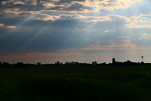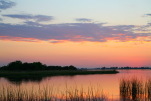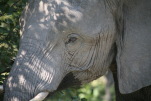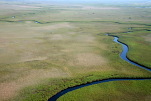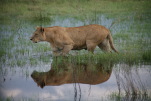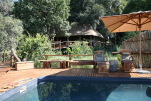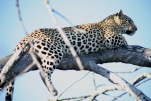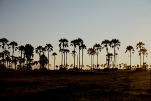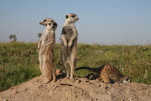In May, 2010, I spent ten days on a safari in Botswana, Africa, to view its wildlife and landscape in three environmentally distinct regions: Linyanti Reserve, Okavango Delta, and Makgadikgadi Pan. By relying on professional guides, I was able to photograph wildlife in their natural habitats as well as observing and photographing different landscapes.
The travel agency, Africa Adventure Company (in Florida state, U.S.A.), arranged the itinerary. DumaTau and Duba Plains Camps were operated by Wilderness Safaris in South Africa. Kwetsani Camp was operated by Ngamiland Adventure Safaris in Botswana and marketed by Wilderness Safaris. Camp Kalahari was operated by Uncharted Africa in Botswana.
Favorite Photos
I took approximately 500 photographs during the trip and over 200 of them are displayed in the following sections. Among the 200, this tiny collection contains my absolute favorites. Serendipity and swift reaction were the key factors in obtaining these photographs. On game drives, I was riding with other guests, so I could not spend too much time waiting for the right conditions. I had to take my shots quickly when fleeting moments presented themselves.
DumaTau Camp
The camp is located in the Linyanti Reserve near the border with Namibia. I stayed in one of the ten comfortable tents on the shore of a lagoon. My tent had two beds, a sink, a hot shower, and a flush toilet. Breakfast and dinner were illuminated by paraffin lanterns that cast a warm glow around the table, where all the guests and some staff dined together. Afternoon tea was served promptly at 3 PM in the lounge. Electricity was provided by batteries that were recharged by a generator.
Wildlife at DumaTau Camp
I enjoyed the guided game drives that began in the morning (6:30 AM) and afternoon (3:30 PM). During the rest period between the game drives, I did laundry, cleaned my camera, and wrote in my journal. The wildlife at DumaTau was numerous and diverse. I had excellent photographic opportunities.
Duba Plains Camp
Located on an island surrounded by the water of the Okavango Delta, I stayed in one of the six tents. The rising water was a constant topic of conversation. If the water gets too deep for the Land Rovers, the camp may have to shutdown. The camp's facilities and amenities were similar to DumaTau Camp.
The nationalities of the guests at this camp were more diverse than other camps, where most guests were Americans. I met people from Switzerland, England, Austria, and U.S.A.
Wildlife at Duba Plains Camp
The camp's location is known for its lions that are locked in a life and death struggle with the cape buffaloes. My realistic chance for observing the lions hunting the buffaloes was very low. I already knew that from my research. While I saw lions following the buffaloes, I did not see any interaction. Nevertheless, photographing the lions up-close was a rare opportunity.
Kwetsani Camp
Just like Duba Plains Camp, Kwetsani Camp is located on an island in the Okavango Delta. Because the water was too deep for the Land Rovers, a motor boat transferred me from the airstrip to the camp of five tents. The boat sped through narrow and winding channels lined with tall papyrus, grass, and water lilies. The same channels were used by hippopotamuses after sunset. The camp's facilities and amenities were similar to DumaTau Camp.
Wildlife at Kwetsani Camp
Due to the deep water, game drives required taking a motor boat to another area and using the Land Rovers there. On the first day, I was disappointed by the lack of wildlife sightings. On the subsequent days, I was amply rewarded by sightings of a male lion, a leopard, a photogenic lilacbreasted roller, and other wildlife.
Camp Kalahari
This camp of ten tents was unlike the other three camps I visited. Its location in the Makgadikgadi Pan allowed me to photograph spectacular landscapes that were both sparse and lush; dry and wet; desolate and lively.
The camp's facilities and amenities were rustic and offered a rugged safari experience. Batteries, which were recharged by solar panels, powered only the essential equipment. Paraffin lamps were used for all lighting. Since I was the only guest in the camp, the camp manager and the guide joined me in almost every meal.
Wildlife at Camp Kalahari
The environment surrounding the camp varied greatly. All the plants and animals had adapted to periods of drought by finding suitable sources of moisture or by migrating. The guide drove a Toyota Land Cruiser that took me on morning and afternoon game drives. During one game drive, I visited the Makgadikgadi Pans National Park.
Mosquitoes were a serious problem during my visit. I was prepared with insect repellent lotion, but I was not adequately prepared for the mosquito's ferociousness. They bit me through my long-sleeved shirt and long pants.
Photographic Tools
- digital camera: Canon EOS 5D.
- memory: SanDisk CompactFlash.
- lens: Canon EF 75-300 mm F4-5.6 III USM, Sigma 24-60 mm F2.8 EX DG.
- bag: Lowepro Nova 4.
- photo processing: GIMP, Canon Digital Photo Professional.
